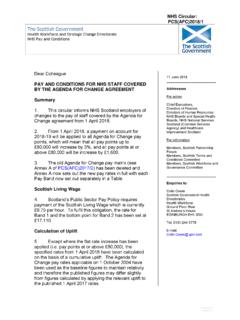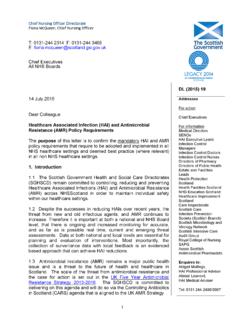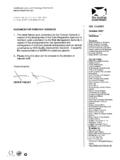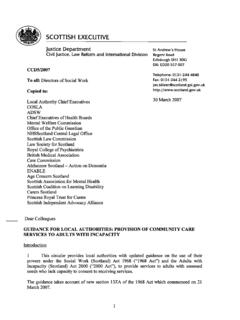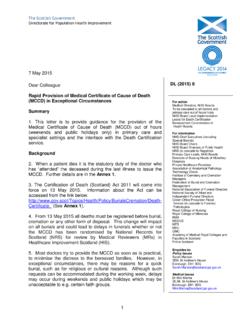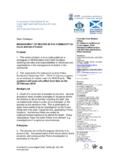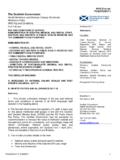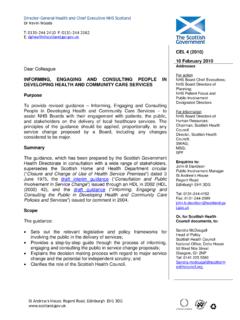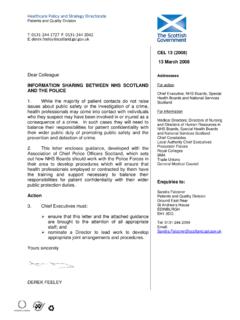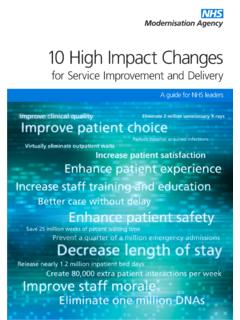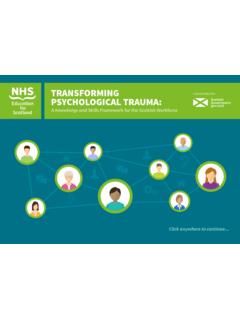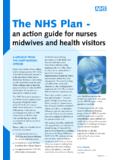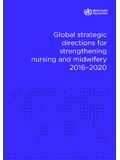Transcription of Directorate of Health Workforce and ... - sehd.scot.nhs.uk
1 A b c d e f g h i j k l m n o p q r s tu Directorate of Health Workforce and Performance Access Support Team Dear Colleague CEL 33 (2012). August 2012. DELIVERING WAITING TIMES. 1. This letter attaches the NHSS cotland Waiting Time Guidance;. the NHS Scotland National Access Policy and Effective patient Addresses booking for NHSS cotland, which are intended to provide additional guidance for Boards to assist them in the delivery of the national For action waiting times standards. Chief Executive, NHS. Boards 2. These documents each relate to 18 weeks Referral to Chief Executives, Special Health Boards Treatment, NEW WAYS Stage of Treatment Standards, the 6 Chief Executive, NHS. week standard for key diagnostic tests and the Treatment Time National Services Guarantee which was contained in the Patient Rights (Scotland) NHS Boards Waiting Times Act 2011.
2 As such these should be read in conjunction with the Executive leads Treatment Time Guarantee Guidance, the Act and the Regulations and Directions. For information Chairs, NHS Boards 3. The NHSS cotland Waiting Time Guidance replaces previous Chairs Special Health 18 weeks: The Referral To Treatment Standard: Principles and Boards Chair, NHS National definitions' (January 2009), and NEW WAYS of Defining and Services Scotland Measuring waiting times' (December 2007). It is written for the use of all staff in NHSS cotland and particularly those involved in collecting and recording information for patients. 4. The National Access Policy aims to ensure consistency of Enquiries to: approach in providing access to services. This policy should be Joyce Wardrope supported by a Local Access Policy developed by each Board St Andrew's House setting out the details of how these principles apply to their local Regent Road services.
3 Edinburgh EH1 3DG. 5. Effective patient booking for NHSS cotland sets out good Tel: 0131-244 3623. practice in booking and management of patient appointments. Point of contact Action 4. Chief Executives must ensure that this letter, the attached documents and all other relevant supporting documents are brought to the attention of all appropriate staff. In particular ensure that: staff are trained to ensure that they fully understand the implications of this guidance and its application. that local policy on waiting times reflects the requirements set out. that your Local Access Policy is developed to support these principles and is made widely available. This includes publication on the Board's website. abcde abc a St Andrew's House, Regent Road, Edinburgh EH1 3DG. Yours sincerely John Connaghan Director of Workforce and Performance abcde abc a St Andrew's House, Regent Road, Edinburgh EH1 3DG.
4 Effective patient booking for NHSS cotland Best practice in the booking and management of patient appointments Crown copyright 2012. The Scottish Government St Andrew's House Edinburgh EH1 3DG. Contents Background .. 4. Booking Models in Operation across NHSS cotland .. 5. Did Not Attend .. 6. Managing Did Not Attend .. 6. Patient Focussed Booking .. 8. Commitment to Equality .. 8. Eight Principles of Effective Patient Focussed Booking Practice .. 9. Recommendations .. 10. Appendix One: Recommended Booking Policy .. 12. Further Resources .. 13. Effective patient booking for NHSS cotland Background The way that appointments are booked can have a profound effect on the efficiency of hospital processes and ultimately the delivery of safe and reliable services for patients. As waiting times in NHSS cotland have reduced, models of patient booking practice have had to evolve to accommodate reducing waits and to embed the principles of New Ways of Defining and Measuring Waiting Times ( issued in December 2007).
5 Booking polices have continued to develop. This document identifies actions that underpin best practice in the booking and management of patient appointments and is commended to NHS Boards. 4. Effective patient booking for NHSS cotland Booking Models in Operation across NHSS cotland There are currently three main models of booking in operation across Scotland: Patient Focussed Booking where a letter is sent to patients' inviting them to make contact to make arrangements for their appointment. Implied Acceptance where patients' are sent a letter offering them an appointment date where the patient's acceptance of that date is assumed (implied) unless the patient makes contact to advise that they are not available. Telephone Booking where arrangements for the appointment are made by telephoning the patient to make the appointment or by writing to the patient asking them to phone in to make arrangements.
6 This method is most commonly used where there are very short waiting times such as in Diagnostic services. 5. Effective patient booking for NHSS cotland Did Not Attend When a patient does not attend an appointment this is known as a Did Not Attend (DNA). DNAs occur for a variety of reasons. Patients' may experience difficulty with transport, weather or home circumstances which make it difficult to keep appointments. There is found to be a link between deprivation and DNA rates and the NHS Boards in Scotland with the highest DNA rates have the highest deprivation indices. DNAs vary by specialty, with Psychiatry and Mental Health having the higher DNA rates in comparison acute specialties such as General Surgery or Orthopaedics. Age is also a factor in patient attendance with those between the ages of 15 49 being the most likely to DNA.
7 Managing Did Not Attend Booking systems allowing patient choice and flexibility have been linked to reduction in DNA rates. The Planned Care Improvement Programme found marked decrease in DNA. rates when PFB was implemented in full. An example of how DNAs reduce with PFB is shown in Table 1, Figure 1 and 2 where PFB. was introduced in October 2009. Calendar Year Clinic type 2008 2009. New Attends 4390 4633. New Attends Did Not Attend 336 221. New Planned Attends 4726 4854. DNA Rate (%) Table 1 DNA Rate PFB Only New Outpatient Appointments Practitioner Base Raigmore Hospital (Old Highland Raigmore and Peripheral Sites). 6. Effective patient booking for NHSS cotland Raigmore Hospital Reducing Did Not Attend Rates (DNAs) with Patient Focused Booking 10. 9 ENT New 8 ENT Return 7. DNA Rate (%). 6 Patient focussed booking was introduced in June 2009.
8 5 for New and Return Patients 4. 3. 2. 1. 0. Jan Feb Mar Apr May Jun Jul Aug Sep Oct Nov Dec Jan Feb Mar Apr May Jun Jul Aug Sep Oct Nov Dec 2009 2010. Figure 1 Trend of Rolling Year DNA rates for ENT Out Patients (New and Return, Raigmore Hospital), Jan 2009 to Dec 2010. Raigmore Hospital Reducing Did Not Attend Rates (DNAs) with Patient Focused Booking 10. 9 Orthopaedics New 8 Orthopaedics Return 7. DNA Rate (%). 6. 5. 4 Patient focussed booking was introduced in August 3 2009 for New Patients 2. 1. 0. Jan Feb Mar Apr May Jun Jul Aug Sep Oct Nov Dec Jan Feb Mar Apr May Jun Jul Aug Sep Oct Nov Dec 2009 2010. Figure 2 Trend of Rolling Year DNA Rates for Orthopaedic Out Patients . (New and Return, Raigmore Hospital), Jan 2009 to Dec 2010. DNA reductions achieved in NHS Boards which have adopted patient focussed booking in full over the last five years has contributed significantly towards the delivery of their local Health improvement, Efficiency, Access and Treatment (HEAT) target for DNAs.
9 7. Effective patient booking for NHSS cotland Patient Focussed Booking The Centre for Change and Innovation (CCI) published guidance on the implementation of patient focussed booking across NHSS cotland in 2006. This guidance was updated in 2007 by the Planned Care Improvement Programme in their publication Patient Pathway Management: Approaches to Booking and Access. The programme found that Patient- Focused Booking (PFB) puts patients at the heart of the booking process by engaging them in a dialogue about their appointment and benefits both patients and the NHS. PFB is about creating a good appointments and waiting list management system, for patients it is about better information and being involved in choosing a convenient appointment that they are more likely to attend.. Patient Pathway Management: Approaches to Booking and Access (May 2007).
10 Commitment to Equality The Healthcare Quality Strategy for NHSS cotland (May 2010) makes a commitment to understanding the needs of different communities, eliminating discrimination and reducing inequality. To meet this commitment there is a need to ensure that information about equality needs is collected and shared to improve the care of individuals and the efficiency of services. For example, by meeting an individual's equality need to receive information in a format or language that can be understood contributes to reducing missed appointments. 8. Effective patient booking for NHSS cotland Eight Principles of Effective Patient Focussed Booking Practice It is proposed that NHS Boards should apply the following eight principles of effective PFB consistently to all outpatient and one-stop clinics to promote attendance and offer choice to patients for the mutual benefit of patients and NHS Boards.
